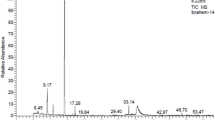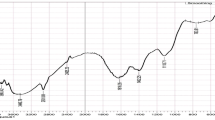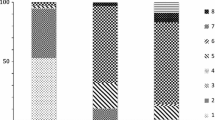Abstract
The mugwortArtemisia vulgaris L. (Compositae: Anthemideae) contains insect repellents which can be released from the plant tissues by combustion. Work was carried out to isolate and identify the repellent compounds. The dried, pulverized whole plants were steam-distilled to give a repellent essential oil which was fractionated by column chromatography. Active fractions were analyzed by capillary GC and by combined GC-MS. A number of compounds, mainly monoterpenoids, were identified. When tested as repellents against the yellow fever mosquitoAedes aegypti L. (Diptera: Culicidae), (±)-linalool, (±)-camphor, (+)-camphor, (−)-camphor, isoborneol, (−)-borneol, terpinen-4-ol, and isobornyl acetate were active at 0.14 mg/cm2 or higher. Nonanone-3, (α+β)-thujone, and bornyl acetate were active at 0.28 mg/cm2 or higher. β-Pinene, myrcene, α-terpinene, (+)− limonene, and cineole were active at 1.4 mg/cm2. Of the repellent compounds identified, terpinen-4-ol was the most active and was as effective as dimethyl phthalate.
Similar content being viewed by others
References
Halligan, J.P. 1975. Toxic terpenes fromArtemisia californica Ecology 56:999–1003.
Inazuka, S. 1982. New methods of evaluation for cockroach repellents and repellency of essential oils against German cockroach (Blatella germanica L.).J. Pest. Sci. 7:133–143.
Inazuka, S. 1983. Monoterpenoids as repellents against the German cockroach (Blattella germanica L.).J. Pest. Sci. 8:293–299.
King, W.V. 1954. Chemical Evaluated as Insecticides and Repellents, USDA Handbook, Orlando, Florida.
Kundu, S.K., Chatterjee, A., andRao, A.S. 1969. Chemical investigation ofArtemisia vulgaris L.J. Indian Chem. Soc. 46:585–594.
Lion, Corp. 1982. Terpene alcohols as mosquito repellents.Jpn.Kokai Tokkyo Koho 82:179101.
Masada, Y. 1976. Analysis of Essential Oils by Gas Chromatography and Mass Spectrometry. John Wiley & Sons, Inc. New York.
Mayer, K. 1952. Prophylaxe und Therapie bei Mückenstichen (I).Pharmazie 7:150–157.
Nano, G.M., Bicchi, C., Frattini, C., andGallino, M. 1976. On the composition of some oils fromArtemisia vulgaris.Planta Med. 30:211–215.
Nano, G.M., Bicchi, C., Frattini, C., andGallino, M. 1977. Vulgarol: A. product of the subsequent oxidation of bornane skeleton present in some essential oils ofArtemisia vulgaris L.Chim. Ind. (Milan) 59:123.
Nitto Electric Industrial Co., Ltd. 1981. Mosquito repellent composition.Jpn. Kokai Tokkyo Koho 81:73007.
Penfold, A.R., andMorrison, F.R. 1952. Some Australian essential oils as insecticides and repellents.Soap, Perfum. Cosmet. 25:933–934.
Rao, P.S., andSood, V.K. 1964. Essential oil fromArtemisia vulgaris.Perfum. Kosmet, 45:63–64.
Scora, R.W., Kumamoto, J., Horner, P.F., andHollenberg, J.L. 1984. Ontogenetic variation and diurnal study in the composition of essential oil inArtemisia douglasiana.J. Nat. Prod. 47:279–284.
Author information
Authors and Affiliations
Additional information
Diptera: Culicidae.
Compositae: Anthemideae.
Rights and permissions
About this article
Cite this article
Hwang, YS., Wu, KH., Kumamoto, J. et al. Isolation and identification of mosquito repellents inArtemisia vulgaris . J Chem Ecol 11, 1297–1306 (1985). https://doi.org/10.1007/BF01024117
Received:
Accepted:
Issue Date:
DOI: https://doi.org/10.1007/BF01024117




